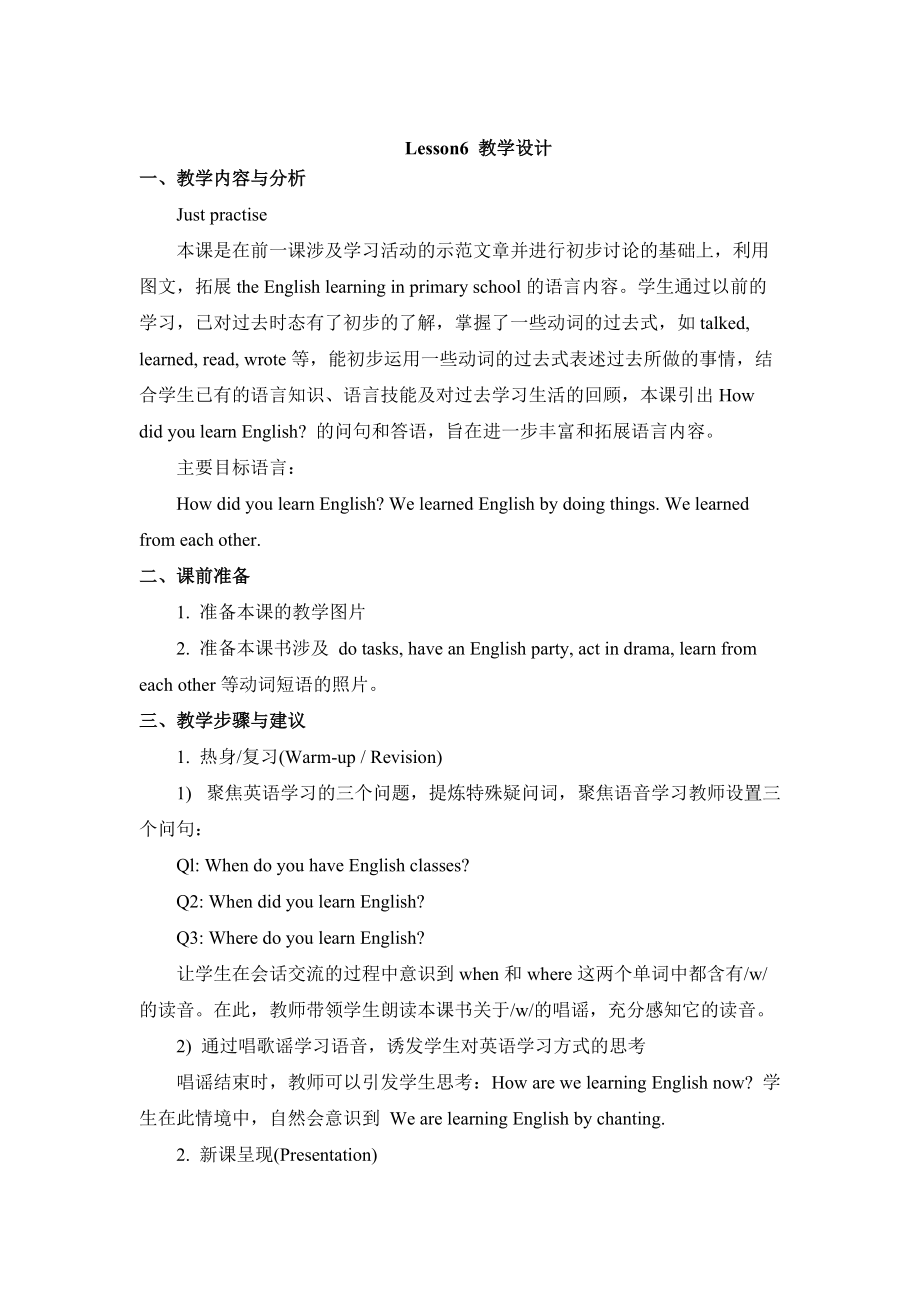《人教精通版英語六下Unit 1I went to Sanya for my holidaysLesson 6教學設計》由會員分享�����,可在線閱讀�,更多相關《人教精通版英語六下Unit 1I went to Sanya for my holidaysLesson 6教學設計(5頁珍藏版)》請在裝配圖網(wǎng)上搜索。
1�����、 精品資料
Lesson6 教學設計
一�、教學內(nèi)容與分析
Just practise
本課是在前一課涉及學習活動的示范文章并進行初步討論的基礎上,利用圖文�����,拓展the English learning in primary school的語言內(nèi)容�。學生通過以前的學習,已對過去時態(tài)有了初步的了解�,掌握了一些動詞的過去式�����,如talked, learned, read, wrote等�,能初步運用一些動詞的過去式表述過去所做的事情�,結(jié)合學生已有的語言知識、語言技能及對過去學習生活的回顧�����,本課引出How did you learn Engli
2�����、sh? 的問句和答語�����,旨在進一步豐富和拓展語言內(nèi)容�。
主要目標語言:
How did you learn English? We learned English by doing things. We learned from each other.
二�、課前準備
1. 準備本課的教學圖片
2. 準備本課書涉及 do tasks, have an English party, act in drama, learn from each other等動詞短語的照片。
三�����、教學步驟與建議
1. 熱身/復習(Warm-up / Revision)
1) 聚焦英語學習的三個問題,提煉特
3�����、殊疑問詞�����,聚焦語音學習教師設置三個問句:
Ql: When do you have English classes?
Q2: When did you learn English?
Q3: Where do you learn English?
讓學生在會話交流的過程中意識到when和where這兩個單詞中都含有/w/的讀音�。在此,教師帶領學生朗讀本課書關于/w/的唱謠�,充分感知它的讀音。
2) 通過唱歌謠學習語音�,誘發(fā)學生對英語學習方式的思考
唱謠結(jié)束時,教師可以引發(fā)學生思考:How are we learning English now? 學生在此情境中�����,自然會意識到 We a
4�����、re learning English by chanting.
2. 新課呈現(xiàn)(Presentation)
1) 短片賞析�����,語言輸入:
教師利用國外兒童英語學習的短片或圖片向?qū)W生介紹他們的學習方式,旨在呈現(xiàn)新知�����,進行語言輸入�。
T: Look at them. They are students of Japan. Do you want to know how they learned English? You may ask like this, “How did you learn?”
教師請學生提問,然后教師開始介紹日本學生學習英語的方式�。學生邊聽邊在學案相應的學習方式處
5、作記錄�。
T: They learned English by doing tasks. They learned English by acting in drama. They learned English by having English parties. They learned English from each other.
Ways of learning
do tasks
have an English
party
act in drama
learn from
each other
do things
2)
6、加深理解�,語言內(nèi)化
教師請學生匯報日本學生學習英語的方式�,在對話交流過程中,幫助學準確理解單詞task和drama的含義�。
T: How did the students learn English?
S: They learned English by doing tasks.
T: Can you do tasks?
S: Yes, I can.
T: What kind of tasks can you do?
S: I can …
T: Did they learn English by acting in drama? (領讀單詞task的基礎上繼續(xù)提問)
S:
7、Yes.
T: Is it drama? (教師呈規(guī)學生表演的短劇《小紅帽》的照片)
S: Yes.
T: How did they learn English? (在領讀單詞drama的基礎上進行提問)
S: They learned English by acting in drama.
3) 會話交流�����,語言輸出
教師請學車思考他們各自的英語學號方式�����,在進行語言示范的基礎上�����,請同學之間相互交流。
T: How did you learn English? Did you learn English like Japanese students? Talk about your
8�、 ways of learning with your desk mates. For example, How did you learn English, Gao Wei?
G: I learned English by having English parties.
T: Yes, that’s a good way.
3. 趣味操練(Practice)
1) 快樂轉(zhuǎn)盤�,操練語句
教師制作一個大轉(zhuǎn)盤,轉(zhuǎn)盤每一個扇面上都是一個英文短語�����。轉(zhuǎn)動轉(zhuǎn)盤�,指針指向哪個短語,學生就要立即用這個短語造句�����。
2) 句子接龍�,操練語句
教師請學生在聽、說�、讀、寫�����、玩、演�����、視聽的過程中進行學習方
9�、法接龍。如:
T: I learned English by singing English songs. How did you learn English? (教師先唱英文歌曲的兩句歌詞�,然后再介紹自己的學習方法,之后教師問一名學生)
S1: I learned English by chanting. How did you learn English? (學生先說唱歌謠�����,然后介紹學習方法�����,之后詢問另一名同學)
S2: I learned English by reading and writing.
4. 語言運用(Language use)
1) 問卷調(diào)查�,經(jīng)驗分享
教師
10�����、向?qū)W生呈現(xiàn)學習方式問卷調(diào)查表�����,要求學生至少采訪5位學生然后教師為學生做一個語言示范。
Names
Ways of learning
Yang
Ming
do tasks
√
act in drama
do role plays
Names
Ways of learning
have an English party
learn from each other
use dictionaries
11�����、
sing English songs
√
see English movies
go on the internet
talk with foreigners
...
語言范例:
T: Hi, Yang Ming. We began to learn English three years ago. Were you interested in English learning?
S1: Yes. I was very interested in it.
T: H
12�、ow did you learn English?
S1: I learned English in many ways. I learned it by singing English songs and doing tasks.
T: That’s good. Thank you.
2) 征文比賽,個人演講
作為本單元的最后一課書�,教師可以有意識地讓學生動筆用英文寫一些小作文。例如�����,在本課書的學習中�,教師可以為學生布置命題作文My English Learning。為便于學生寫好小短文�,教師可以為學生提供寫作提綱。學生在寫作的基礎上�����,進行個人演講�����。
My English Lear
13�����、ning
Hints: When did you begin to learn English?
Were you interested in English learning?
What did you often do in English lessons?
How did you learn English?
Did you do a good job in English learning?
5. 課堂評價(Assessment)
1) 課堂教學過程中的評價
教師在課上設計演講比賽,評選最佳口才獎�、最佳學習方法獎
小組合作制作海報,評選最佳設計獎�,最佳學習方法獎和最佳合作小組。
組織學生�����,根據(jù)自己的課上表現(xiàn)�����,開展自評活動:
評價目標
聽懂
會說
會寫(或會表演)
我能夠能夠掌握本單元所學的新詞語并能夠?qū)嶋H運用
我能夠回顧過去已經(jīng)學過的與學習相關的各種表達方法
我能夠熟練運用所學的語言知識參與課堂討論
我能夠配合小組內(nèi)的其他同學共同完成本小組的海報設計
2) 教師指導學生完成《活動手冊》中的相關內(nèi)容�,并進行評價。
最新精品英語資料
 人教精通版英語六下Unit 1I went to Sanya for my holidaysLesson 6教學設計
人教精通版英語六下Unit 1I went to Sanya for my holidaysLesson 6教學設計

